Diet food product
a food product and diet technology, applied in the field of diet food products, can solve the problems of stress and lack of exercise, obesity and associated increase in body fat percentage, and most people do not have time, so as to improve metabolism, improve carbohydrate metabolism and lipid metabolism, and improve blood circulation
- Summary
- Abstract
- Description
- Claims
- Application Information
AI Technical Summary
Benefits of technology
Problems solved by technology
Method used
Image
Examples
example 1
[0053] A pine bark extract (trade name: Flavangenol, produced by TOYO SHINYAKU Co., Ltd.) containing 40 wt % of proanthocyanidins (OPC content: 20 wt % in the extract), a spice extract (Nippon Shinyaku Co., Ltd.) containing 2.7 wt % of capsaicin, crystalline cellulose, sucrose ester, silicon dioxide, and eggshell calcium were mixed in a ratios (wt %) shown in Table 1 below, and tablets (weight of tablets: 200 mg per tablet) were produced from the resultant mixture. The tablets were referred to as “Food 1”.
[0054] A total of 30 volunteers who had made an unsuccessful attempt to go on a diet served as subjects. Among them, 10 volunteers who were randomly selected and assigned to one group ingested the above-described Food 1, and the effect of improving basal metabolism and the effect of improving blood circulation were evaluated in the following manner.
[0055] First, before the ingestion of the Food 1, skin temperature at the extremities of the above-described 10 volunteers was measur...
example 2
[0063] The pine bark extract containing 40 wt % of proanthocyanidins (OPC content: 20 wt % in the extract) in Example 1 and a capsicum extract (Nippon Shinyaku Co., Ltd.) were dissolved in water in the ratios (wt %) shown in Table 3 to obtain a beverage. This beverage was employed to evaluate the diet effect on rats based on the body weight gain inhibition rate in the following manner.
[0064] First, male SD rats (Charles River Japan, Inc.) at the age of four weeks were given only a standard feed and water for one week for acclimation. Then, the body weight of each of the rats was measured, and the rats were divided into groups of 5 each so that the average of the weights was almost equal among the groups. Next, each of the rats was orally administered 1 mL of the beverage daily for seven days with a sonde. The rats were allowed to freely ingest drinking water that was a 25% fructose solution and a feed that was the standard feed. A control group in which purified water was administe...
examples 3 to 7
[0066] An aqueous solution was prepared using one or two of a Coleus forskohlii extract (Santrex Co., Ltd.), L-carnitine (KONGO CHEMICAL CO., LTD.), CoQ10 (NISSHIN PHARMA INC.), and citrus extract powder (MATSUURA KAMPO KK) as shown in Table 3 in place of the capsicum extract in Example 2 so that the concentrations in each of the components in the aqueous solution were as shown in Table 3. Operations were performed in the same manner as in Example 2 except that this aqueous solution was used as the beverage, and the body weight gain rate, the feed intake amount, and the body weight gain inhibition rate were obtained. Table 4 shows the results.
PUM
| Property | Measurement | Unit |
|---|---|---|
| wt % | aaaaa | aaaaa |
| stress | aaaaa | aaaaa |
| temperature | aaaaa | aaaaa |
Abstract
Description
Claims
Application Information
 Login to View More
Login to View More - R&D
- Intellectual Property
- Life Sciences
- Materials
- Tech Scout
- Unparalleled Data Quality
- Higher Quality Content
- 60% Fewer Hallucinations
Browse by: Latest US Patents, China's latest patents, Technical Efficacy Thesaurus, Application Domain, Technology Topic, Popular Technical Reports.
© 2025 PatSnap. All rights reserved.Legal|Privacy policy|Modern Slavery Act Transparency Statement|Sitemap|About US| Contact US: help@patsnap.com

